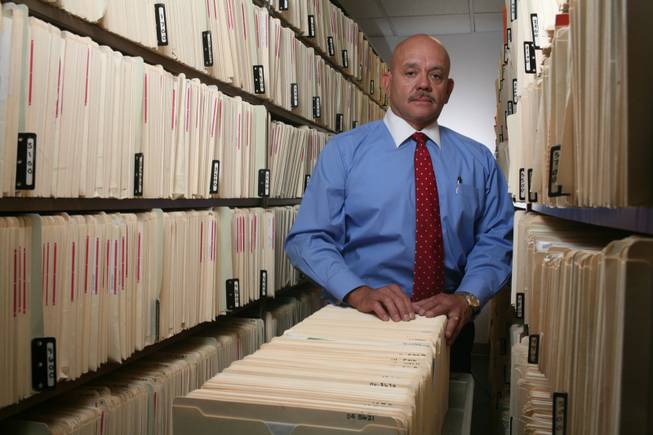
The local situation: Clark County Coroner Mike Murphy shows the equivalent of 258 case files — the number of deaths from prescription narcotics overdoses in 2007 — in the coroner’s office file room Wednesday. Murphy has called the prescription drug deaths a “dire situation.”
Monday, July 7, 2008 | 2 a.m.
Sun Series: The New Addiction
- Part 1: The painful truth about Nevada (7-6-2008)
- Part 2: Rising use of painkillers taking deadly toll (7-7-2008)
- Part 3: Officials urge action on painkiller abuse (7-8-2008)
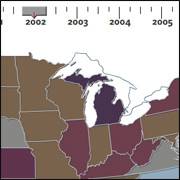
Sun Interactive
Reader poll
Beyond the Sun
The skyrocketing use and abuse of prescription narcotics in Las Vegas is accompanied by a similarly startling increase in the number of fatal overdoses, a Sun analysis has found.
Fatal overdoses involving prescription painkillers more than quadrupled in a decade and now exceed those involving illicit drugs, according to data compiled by the Clark County coroner’s office.
The trend reflects the extraordinarily high use of narcotic painkillers by Nevadans. The Sun reported Sunday that its analysis of Drug Enforcement Administration data shows that Nevadans per person use more hydrocodone — the potent ingredient in the drugs Vicodin, Lortab and Norco — than residents of any other state. Nevadans rank fourth nationally in per person consumption of methadone, morphine and oxycodone, the main ingredient in OxyContin.
The increased use and availability of the drugs are primary factors in the rise of addiction, illegal distribution and fatal overdoses, experts say.
In 1997, there were 57 fatal overdoses in Clark County in which prescription narcotics were a contributing factor, a rate of about five per 100,000 people. In 2007, 258 people died in Clark County from overdoses of prescription narcotics, a rate of 13 per 100,000 people.
In contrast, the number of deaths caused by illicit drugs has plateaued. Street drugs such as cocaine, methamphetamine and heroin were involved in a combined 197 fatal overdoses in 2007.
Deaths involving prescription narcotics exceeded or rivaled those caused by firearms (321) and motor vehicle accidents (234) in Clark County in 2007.
Clark County Coroner Mike Murphy called the prescription drug deaths a “dire situation.”
Doctors who specialize in pain management, and pharmaceutical companies that make the drugs, emphasize that many people are helped by prescription narcotics while acknowledging that a small percentage may become addicted.
Prescription drug overdoses draw national attention when the victims include such celebrities as Heath Ledger and Anna Nicole Smith, but aside from the sensational anecdotes, little is reported about the overall toll of overdoses.
Poisoning, usually caused by unintentional drug overdose, is the second leading cause of injury death in the United States, surpassing firearms in 2004, according to the National Center for Health Statistics.
Prescription narcotics deaths accounted for 56 percent of poisoning deaths nationally in 2005, according to the Centers for Disease Control and Prevention, and their absolute number increased by 84 percent from 1999 to 2005.
Some regional data compiled by medical examiners further illustrate the problem:
• In King County, Washington (Seattle), prescription opiates killed 148 people in 2006, a 572 percent increase since 1997.
• In Virginia, prescription narcotics took 399 lives in 2006, compared with 146 deaths from cocaine and amphetamines.
• In Oklahoma, of 603 drug-related deaths in 2006, more than half, 327, were attributed to hydrocodone, methadone or oxycodone.
• In Florida, people who died of drug overdoses in 2007 had prescription drugs in their systems more often than illicit drugs.
No prescribed narcotic is involved in more deaths among Nevadans than methadone. The long-acting painkiller was named in a third of the 1,771 prescription drug overdoses in Clark County from 1991 to 2007, according to the Clark County coroner’s office. The number of deaths involving methadone climbed from three in 1993 to 20 in 1998 and 105 in 2007. (Cocaine was a factor in 116 Clark County deaths in 2007.)
Methadone, widely used to wean addicts off other drugs, has grown in popularity as a painkiller in recent years. Several doctors said it’s preferred by insurance companies because it’s inexpensive — though insurers dispute this, saying there are many low-cost generic narcotics so there would be no reason to favor methadone.
But methadone is a challenging drug to prescribe because it stays in a person’s system for five to 11 days, even after its effects have worn off, said Las Vegas pain specialist Dr. Jim Marx. That means a patient could take multiple doses of methadone over time to keep pain in check, allowing potentially lethal amounts of the drug to build up in the body. In comparison, hydrocodone leaves the body within hours.
“It’s trickier to prescribe because of its persistence,” Marx said.
Methadone deaths have increased more than those involving any other narcotic, the Centers for Disease Control and Prevention reports.
Its data show Nevada had almost four methadone deaths per 100,000 people from 1999 to 2005, the fourth-highest rate in the United States, behind Maine, Utah and Washington.
The CDC said it’s hard to determine whether the increase in opioid-related deaths is due to prescribing practices, a failure by patients to take drugs properly, or illegal abuse.
CDC medical epidemiologist Leonard Paulozzi told Congress in March the drug overdose deaths correspond to the rapidly rising rates of prescription narcotic use reported by the Drug Enforcement Administration, and the overdose deaths are expected to continue.
Statistics through 2005 “probably underestimate the present magnitude of the problem,” Paulozzi said.
•••
There are many ways to get prescription narcotics illegally, said Matt Alberto, deputy chief of investigations for the Nevada Public Safety Department, the state’s lead prescription drug policing agency.
Unscrupulous doctors sell prescriptions for cash. Abusers shop for doctors who prescribe narcotic painkillers without asking many questions. Children fish around in their parents’ medicine cabinets. Patients forge prescriptions. Pharmacy workers, clinic workers and hospital employees steal the drugs.
The most notorious criminal case of a doctor in Las Vegas illegally providing narcotic drugs involves Dr. Harriston Bass Jr., who, according to evidence at his trial, made house calls to prescribe and distribute prescription narcotics.
Bass drove to patients’ homes, conducted 10-minute exams and then sold the patients two or three bottles of 100 pills each — even though he had no license to distribute controlled substances, according to testimony at his trial. He also wrote prescriptions for patients to fill at pharmacies.
Among his patients was Gina Micali, who received about 300 hydrocodone tablets from Bass every other month, plus a prescription for another 180 and one refill. On each visit she also received the muscle relaxant Soma and the anxiety medication Xanax, plus prescriptions for each. In pills and prescriptions, Bass sold Micali a total of about 1,400 pills per visit, said Conrad Hafen, the chief deputy attorney general, who prosecuted the case.
On Oct. 5, 2005, Micali, 38, died after ingesting too many painkillers she got from Bass.
Hafen told the jury that when police searched Bass’ home, they found $150,000 in cash and large quantities of hydrocodone in bottles labeled with the name of his company — DOCS-24-7 — and a wholesale prescription drug company in Illinois.
Alberto said the Illinois company offered no good explanation for why it was selling drugs to a doctor who didn’t have clearance from the Drug Enforcement Administration.
In March, Bass was convicted of second-degree murder in Micali’s death and was found guilty on more than 50 drug-related charges. He was sentenced to 25 years to life in prison.
A more typical case of illegally diverting prescription painkillers involves Stephanie Ortiz, a former pharmacy technician at four Smith’s grocery stores in Las Vegas. She admitted to the pharmacy board that she gave unauthorized refills of Lortab — a painkiller made with hydrocodone — and free drugs to friends posing as patients. Ortiz filled out refill requests but never faxed or phoned them to physicians for approval, the complaint against her says. She admitted illegally diverting 10,680 doses of the painkiller.
In a letter she wrote admitting her guilt, Ortiz says she started giving the purloined drugs to people she knew, and then got text messages and phone calls saying a random person would come by for another pickup. In exchange for the drugs, Ortiz said, she received VIP tables at nightclubs and access to hotel rooms on busy weekends.
Authorities say young people are cavalier with prescription drugs, sharing them among themselves or sneaking them from their parents and passing them around to their friends. Such a transaction ended in death two years ago this week in Mesquite.
According to an affidavit filed by the Nevada Public Safety Department, Brett Sawyer, 19, was found dead in his bedroom on July 8, 2006. Hidden in a gym bag by his bed was an empty bottle of hydrocodone pills prescribed by a dentist in St. George, Utah, to one of his friends.
Sawyer’s family told investigators he was a drug user. “Brett was the type — if one aspirin worked, three would work better,” his mother said.
Police learned that Sawyer was addicted to OxyContin and often obtained drugs from Cody Morris, who was also an addict and dealt the drugs to his friends.
On July 7, 2006, Morris sold Sawyer three 80 mg OxyContin pills — what some call the Cadillac of prescription narcotics — for $45 each. Morris said he warned Sawyer not to take more than one at a time and to avoid mixing them with alcohol.
Sawyer was dead the next day.
Morris pleaded guilty to manslaughter and was sentenced to three years’ probation.
Alberto, the investigator, said it’s as common for drug dealers to sell prescription narcotics as it is methamphetamine or cocaine — and more profitable. An ounce of methamphetamine might sell wholesale in Las Vegas for $700, he said, but the same weight in OxyContin pills would be $3,000. He guessed the illegal abuse of prescription painkillers could account for 10 percent of the state’s total use.
Alberto laments that policymakers and the public are focused on street drugs, and virtually ignore the dangers in people’s medicine cabinets. Narcotics investigators for Metro Police do not investigate prescription drug dealing and deal with the drugs only on a reactive basis, a spokesman said.
Yet prescription narcotics are becoming more popular than marijuana for new abusers. The 2006 National Survey on Drug Use and Health found that among new drug abusers, 2.2 million people chose prescription painkillers and 2.1 million preferred marijuana.
Nothing stimulates the brain with pleasure more than drugs. But doctors disagree about the threat of drug addiction. People at risk of becoming addicted to them range from 3 percent to 18 percent of the population, depending on the study or the expert.
Prescription narcotics can change the brain’s chemistry, creating a physical and psychological dependence that compels addicts to forgo career, children, money, sleep, sex and all-around well-being in pursuit of the drug of choice.
Officials with the Nevada Substance Abuse Prevention and Treatment Agency say the rise in prescription narcotic addiction in the state cannot be quantified because of the way records are kept. Nationally, a 2006 Substance Abuse and Mental Health Services Administration survey showed that an estimated 5.2 million people 12 and older took narcotic painkillers for nonmedical purposes 30 days before the survey, up from about 4.4 million in 2002.
People seem to think that because the drugs are commercially manufactured and approved by the Food and Drug Administration, their abuse is less risky than that of illicit drugs, said Steve Pasierb, president of the Partnership for a Drug-Free America.
“This is a deadly behavior,” Pasierb said of the drug abuse. “When prescription drugs are abused in the same way as illegal street drugs, they’re every bit as addictive and they’re every bit as deadly.”
Part Three in this Series: Officials urge action on painkiller abuse
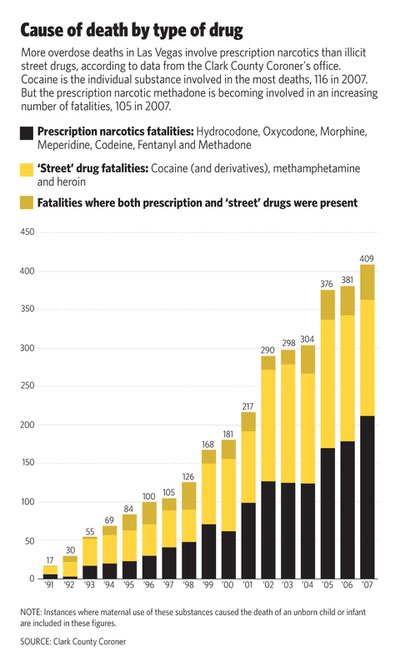
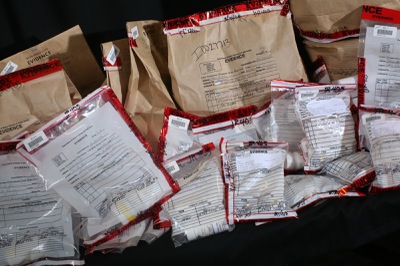
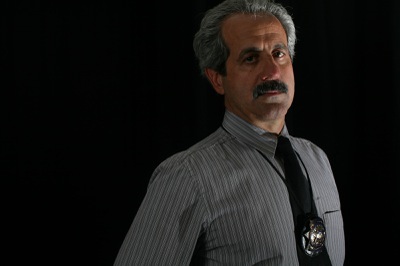
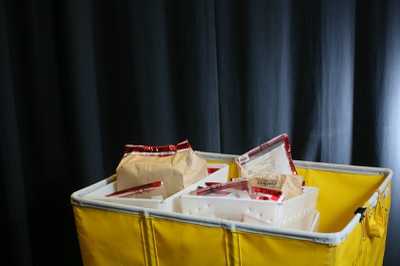

Join the Discussion:
Check this out for a full explanation of our conversion to the LiveFyre commenting system and instructions on how to sign up for an account.
Full comments policy